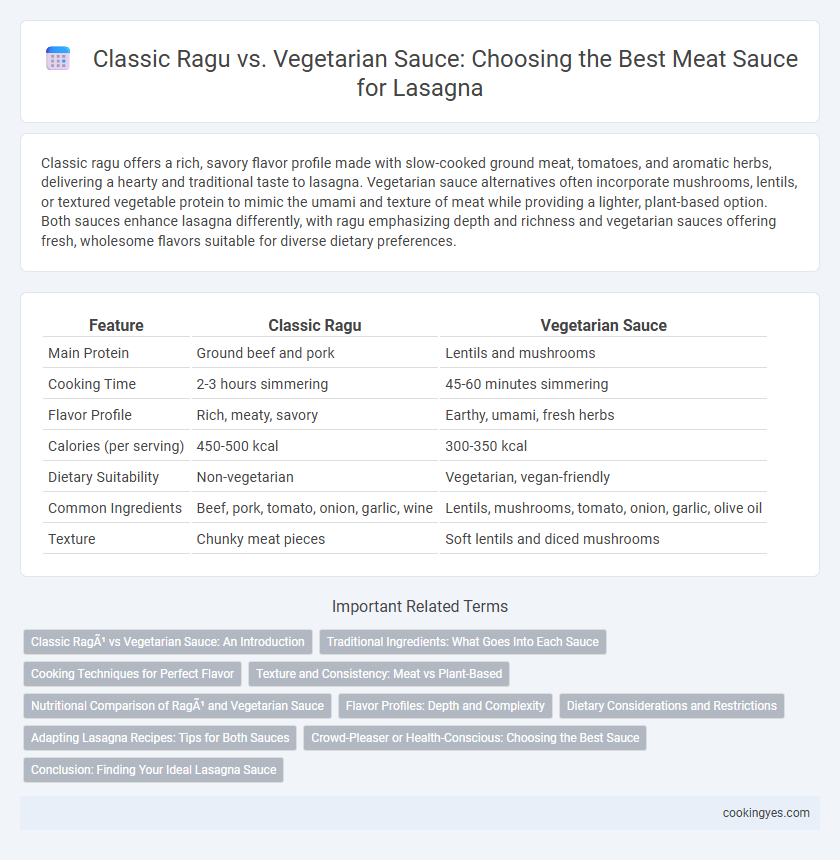Classic ragu offers a rich, savory flavor profile made with slow-cooked ground meat, tomatoes, and aromatic herbs, delivering a hearty and traditional taste to lasagna. Vegetarian sauce alternatives often incorporate mushrooms, lentils, or textured vegetable protein to mimic the umami and texture of meat while providing a lighter, plant-based option. Both sauces enhance lasagna differently, with ragu emphasizing depth and richness and vegetarian sauces offering fresh, wholesome flavors suitable for diverse dietary preferences.
Table of Comparison
| Feature | Classic Ragu | Vegetarian Sauce |
|---|---|---|
| Main Protein | Ground beef and pork | Lentils and mushrooms |
| Cooking Time | 2-3 hours simmering | 45-60 minutes simmering |
| Flavor Profile | Rich, meaty, savory | Earthy, umami, fresh herbs |
| Calories (per serving) | 450-500 kcal | 300-350 kcal |
| Dietary Suitability | Non-vegetarian | Vegetarian, vegan-friendly |
| Common Ingredients | Beef, pork, tomato, onion, garlic, wine | Lentils, mushrooms, tomato, onion, garlic, olive oil |
| Texture | Chunky meat pieces | Soft lentils and diced mushrooms |
Classic Ragù vs Vegetarian Sauce: An Introduction
Classic ragu features a rich combination of ground beef, pork, tomatoes, onions, and herbs, simmered slowly to develop deep, savory flavors essential for authentic Italian lasagna. Vegetarian sauce substitutes meat with hearty vegetables such as mushrooms, zucchini, and bell peppers, enhanced with garlic, tomatoes, and aromatic herbs to create a flavorful, plant-based alternative. Both sauces provide distinct textures and taste profiles, catering to different dietary preferences while maintaining the essence of traditional lasagna.
Traditional Ingredients: What Goes Into Each Sauce
Classic ragu features ground beef, pork, pancetta, onions, carrots, celery, tomatoes, red wine, and a slow simmer to develop rich, deep flavors. Vegetarian sauce replaces meat with mushrooms, lentils, or textured vegetable protein, combined with tomatoes, garlic, onions, carrots, and herbs like basil and oregano to mimic the hearty texture and umami taste. Both sauces rely on traditional Italian aromatics and long cooking times but differ significantly in protein sources and flavor profiles.
Cooking Techniques for Perfect Flavor
Classic ragu requires slow simmering of ground beef and pork with tomatoes, wine, and aromatic vegetables, allowing fats and collagen to develop a rich, deep flavor and tender texture. Vegetarian sauce often relies on slow-cooked mushrooms, lentils, or textured vegetable protein combined with tomato base and herbs to mimic the umami and heartiness of meat while maintaining moisture. Proper layering and controlled heat during simmering ensure balanced flavors and the perfect consistency for lasagna.
Texture and Consistency: Meat vs Plant-Based
Classic ragu offers a rich, hearty texture with tender chunks of slow-cooked meat that create a dense, satisfying consistency. Vegetarian sauces, often made from lentils, mushrooms, or textured vegetable protein, provide a lighter, more varied texture with a balance of softness and bite. The meat sauce tends to be thicker and more gelatinous due to the collagen breakdown, while plant-based sauces often have a thinner, chunkier consistency offering a different mouthfeel.
Nutritional Comparison of Ragù and Vegetarian Sauce
Classic ragu, typically made with ground beef, pork, and tomatoes, offers high protein content and essential amino acids, but also contains higher saturated fats and cholesterol. Vegetarian sauce, often based on lentils, mushrooms, or legumes, provides a rich source of fiber, antioxidants, and lower calories, promoting heart health and digestion. Comparing nutritional profiles highlights that ragu delivers more complete protein, while vegetarian sauce excels in fiber and micronutrients, making both options suitable depending on dietary goals.
Flavor Profiles: Depth and Complexity
Classic ragu offers rich, savory depth from slow-cooked beef, pork, and aromatic vegetables, creating a complex umami flavor with hints of tomato and herbs. Vegetarian sauce emphasizes bright, fresh flavors using ingredients like mushrooms, lentils, and seasonal vegetables, providing a layered, earthy complexity without meat. Both sauces deliver intense flavor profiles, but ragu leans toward hearty richness while vegetarian sauce highlights vibrant, plant-based nuances.
Dietary Considerations and Restrictions
Classic ragu in lasagna features ground beef, pork, and sometimes veal, making it rich in protein but high in saturated fats and unsuitable for vegetarians and vegans. Vegetarian sauce alternatives often use lentils, mushrooms, or plant-based meat substitutes, catering to those with dietary restrictions like vegetarianism, veganism, or lower cholesterol needs. Both sauces can be adjusted for gluten-free diets by choosing appropriate pasta or thickening agents, offering flexibility for diverse dietary preferences.
Adapting Lasagna Recipes: Tips for Both Sauces
Classic ragu offers a rich, slow-cooked blend of ground beef, pork, tomatoes, and aromatic herbs, perfect for traditional lasagna layers. Vegetarian sauce alternatives use hearty vegetables like mushrooms, zucchini, and lentils to mimic the meatiness while maintaining a flavorful tomato base. Adapting lasagna recipes involves balancing moisture levels, seasoning intensity, and layering techniques to ensure both ragu and vegetarian sauces achieve optimal texture and taste in the final dish.
Crowd-Pleaser or Health-Conscious: Choosing the Best Sauce
Classic ragu offers a rich, savory flavor with slow-cooked ground beef, pork, tomatoes, and aromatic herbs, making it a crowd-pleaser for traditional lasagna lovers. Vegetarian sauce features hearty vegetables, lentils, or mushrooms, providing a nutritious and lower-fat option ideal for health-conscious diners or those avoiding meat. Selecting between these sauces depends on balancing robust taste preferences with dietary goals to satisfy varied palates.
Conclusion: Finding Your Ideal Lasagna Sauce
Classic ragu offers a rich, slow-cooked blend of ground beef, pork, tomatoes, and aromatic herbs that deliver deep umami and traditional Italian flavor, ideal for meat lovers seeking authenticity. Vegetarian sauces, often based on mushrooms, lentils, or roasted vegetables with tomato and herb bases, provide a hearty, nutritious alternative with robust textures and flavors that satisfy plant-based preferences. Choosing your ideal lasagna sauce depends on balancing taste preferences, dietary needs, and desired complexity, ensuring a personalized and enjoyable dining experience.
Classic ragù vs Vegetarian sauce for meat sauce Infographic

 cookingyes.com
cookingyes.com